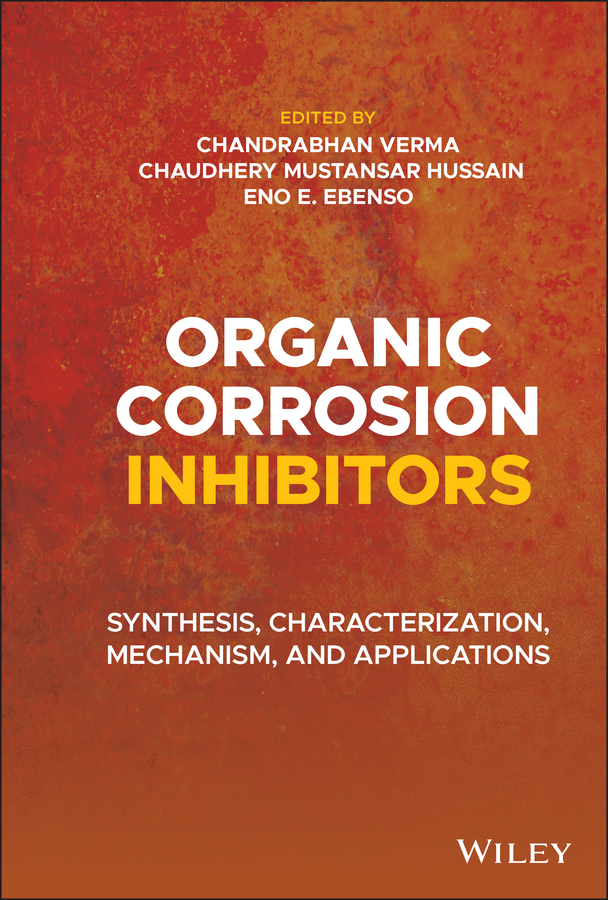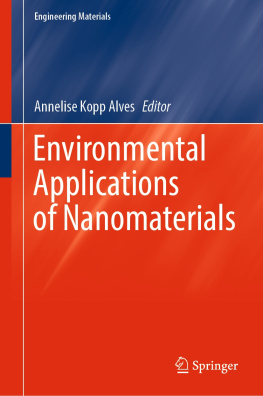Eno E. Ebenso (editor) - Organic corrosion inhibitors : synthesis, characterization, mechanism, and applications
Here you can read online Eno E. Ebenso (editor) - Organic corrosion inhibitors : synthesis, characterization, mechanism, and applications full text of the book (entire story) in english for free. Download pdf and epub, get meaning, cover and reviews about this ebook. year: 2022, genre: Science. Description of the work, (preface) as well as reviews are available. Best literature library LitArk.com created for fans of good reading and offers a wide selection of genres:
Romance novel
Science fiction
Adventure
Detective
Science
History
Home and family
Prose
Art
Politics
Computer
Non-fiction
Religion
Business
Children
Humor
Choose a favorite category and find really read worthwhile books. Enjoy immersion in the world of imagination, feel the emotions of the characters or learn something new for yourself, make an fascinating discovery.

- Book:Organic corrosion inhibitors : synthesis, characterization, mechanism, and applications
- Author:
- Genre:
- Year:2022
- Rating:5 / 5
- Favourites:Add to favourites
- Your mark:
- 100
- 1
- 2
- 3
- 4
- 5
Organic corrosion inhibitors : synthesis, characterization, mechanism, and applications: summary, description and annotation
We offer to read an annotation, description, summary or preface (depends on what the author of the book "Organic corrosion inhibitors : synthesis, characterization, mechanism, and applications" wrote himself). If you haven't found the necessary information about the book — write in the comments, we will try to find it.
Organic corrosion inhibitors : synthesis, characterization, mechanism, and applications — read online for free the complete book (whole text) full work
Below is the text of the book, divided by pages. System saving the place of the last page read, allows you to conveniently read the book "Organic corrosion inhibitors : synthesis, characterization, mechanism, and applications" online for free, without having to search again every time where you left off. Put a bookmark, and you can go to the page where you finished reading at any time.
Font size:
Interval:
Bookmark:

- Chapter 5
- Chapter 6
- Chapter 7
- Chapter 8
- Chapter 9
- Chapter 12
- Chapter 13
- Chapter 14
- Chapter 15
- Chapter 16
- Chapter 18
- Chapter 19
- Chapter 20
- Chapter 1
- Chapter 2
- Chapter 3
- Chapter 4
- Chapter 6
- Chapter 7
- Chapter 8
- Chapter 9
- Chapter 10
- Chapter 11
- Chapter 12
- Chapter 13
- Chapter 14
- Chapter 15
- Chapter 16
- Chapter 17
- Chapter 18
- Chapter 19
- Chapter 20
Edited by
Chandrabhan Verma
King Fahd University of Petroleum and Minerals
Dhahran, Saudi Arabia
Chaudhery Mustansar Hussain
New Jersey Institute of Technology
Newark, NJ, USA
Eno E. Ebenso
University of South Africa
Johannesburg, South Africa

This edition first published 2022
2022 John Wiley & Sons, Inc.
All rights reserved. No part of this publication may be reproduced, stored in a retrieval system, or transmitted, in any form or by any means, electronic, mechanical, photocopying, recording or otherwise, except as permitted by law. Advice on how to obtain permission to reuse material from this title is available at http://www.wiley.com/go/permissions.
The right of Chandrabhan Verma, Chaudhery Mustansar Hussain, and Eno E. Ebenso to be identified as author(s) of the editorial material in this work has been asserted in accordance with law.
Registered Office
John Wiley & Sons, Inc., 111 River Street, Hoboken, NJ 07030, USA
Editorial Office
111 River Street, Hoboken, NJ 07030, USA
For details of our global editorial offices, customer services, and more information about Wiley products visit us at www.wiley.com.
Wiley also publishes its books in a variety of electronic formats and by printondemand. Some content that appears in standard print versions of this book may not be available in other formats.
Limit of Liability/Disclaimer of Warranty
In view of ongoing research, equipment modifications, changes in governmental regulations, and the constant flow of information relating to the use of experimental reagents, equipment, and devices, the reader is urged to review and evaluate the information provided in the package insert or instructions for each chemical, piece of equipment, reagent, or device for, among other things, any changes in the instructions or indication of usage and for added warnings and precautions. While the publisher and authors have used their best efforts in preparing this work, they make no representations or warranties with respect to the accuracy or completeness of the contents of this work and specifically disclaim all warranties, including without limitation any implied warranties of merchantability or fitness for a particular purpose. No warranty may be created or extended by sales representatives, written sales materials or promotional statements for this work. The fact that an organization, website, or product is referred to in this work as a citation and/or potential source of further information does not mean that the publisher and authors endorse the information or services the organization, website, or product may provide or recommendations it may make. This work is sold with the understanding that the publisher is not engaged in rendering professional services. The advice and strategies contained herein may not be suitable for your situation. You should consult with a specialist where appropriate. Further, readers should be aware that websites listed in this work may have changed or disappeared between when this work was written and when it is read. Neither the publisher nor authors shall be liable for any loss of profit or any other commercial damages, including but not limited to special, incidental, consequential, or other damages.
Library of Congress CataloginginPublication Data
Names: Verma, Chandrabhan, editor. | Hussain, Chaudhery Mustansar, editor. | Ebenso, Eno E., editor.
Title: Organic corrosion inhibitors : synthesis, characterization, mechanism, and applications / edited by Chandrabhan Verma, Chaudhery Mustansar Hussain, Eno E. Ebenso.
Description: First edition. | Hoboken, NJ : Wiley, 2022. | Includes index.
Identifiers: LCCN 2021031915 (print) | LCCN 2021031916 (ebook) | ISBN 9781119794486 (cloth) | ISBN 9781119794493 (adobe pdf) | ISBN 9781119794509 (epub)
Subjects: LCSH: Corrosion and anticorrosives. | Corrosion and anticorrosivesEnvironmental aspects.
Classification: LCC TA462 .O65 2022 (print) | LCC TA462 (ebook) | DDC 620.1/1223dc23
LC record available at https://lccn.loc.gov/2021031915
LC ebook record available at https://lccn.loc.gov/2021031916
Cover Design and Image: Wiley
Corrosion is a highly dangerous phenomenon that causes huge economic and safety problems. Various methods of corrosion monitoring, including cathodic protection, panting and coatings, alloying and dealloying (reduction in metal impurities), surface treatments, and use of corrosion inhibitors have been developed depending upon the nature of metal and environment. Application of organic compounds, especially heterocyclic compounds, is one of the most common, practical, easy, and economic methods of corrosion mitigations. Obviously, these compounds become effective by adsorbing on the metallic surface using electronrich centers including multiple bonds and polar functional groups. These electronrich centers act as adsorption sites during their interaction with the metallic surface. Along with acting as adsorption sites, the polar functional groups such as OH (hydroxyl), NH2 (amino), OMe (methoxy), COOH (carboxyl), NO2 (nitro), CN (nitrile), and so on also enhance solubility of organic compounds in polar electrolytes. Present book describes the collection of major advancements in using organic compounds as corrosion inhibitors including their synthesis, characterization, and corrosion inhibition mechanism.
Through this book it can be seen that use of organic compounds serves as one of the most effective, economic, and ease methods of corrosion monitoring. Using previously developed methods, 15% (US $375) to 35% (US $875) of cost of corrosion can be minimized. Different series of organic compounds, including heterocyclic compounds, are effectively used as corrosion inhibitors for different metals and alloys in various environments. Because of the increasing ecological awareness and strict environmental regulations, various classes of environmentalfriendly alternatives to the traditional toxic corrosion inhibitors have been developed and being implemented. These series of compounds mostly include carbohydrates, natural polymers and amino acids (AAs), and their derivatives. Corrosion scientists and engineers strongly believe that these environmentalfriendly alternatives will be capable to replace, in the near future, the toxic marketable products that are still being used via many worldwide industries.
A book covering the recent developments on using organic compounds as corrosion inhibitors is broadly overdue. It has been addressed by Drs. Verma, Hussain, and Ebenso in this book which attends to fundamental characteristics of organic corrosion inhibitors, their synthesis and characterization, chronological growths, and their industrial applications. The corrosion inhibition using organic compounds, especially heterocyclic compounds, is broad ranging. This book is divided into five sections, where each section contains several chapters. Section 1 Basics of corrosion and prevention describes the basic of corrosion, experimental and computational testing of corrosion, and a comparison between organic and inorganic corrosion inhibitors. Section 2 Heterocyclic and nonheterocyclic corrosion inhibitors describes the collection of different series of heterocyclic and nonheterocyclic corrosion inhibitors such as amines, imidazole, quinoline, pyridine, indole, and their derivatives. This section also includes organic compounds as corrosion inhibitors for oil and gas industries.
Next pageFont size:
Interval:
Bookmark:
Similar books «Organic corrosion inhibitors : synthesis, characterization, mechanism, and applications»
Look at similar books to Organic corrosion inhibitors : synthesis, characterization, mechanism, and applications. We have selected literature similar in name and meaning in the hope of providing readers with more options to find new, interesting, not yet read works.
Discussion, reviews of the book Organic corrosion inhibitors : synthesis, characterization, mechanism, and applications and just readers' own opinions. Leave your comments, write what you think about the work, its meaning or the main characters. Specify what exactly you liked and what you didn't like, and why you think so.

